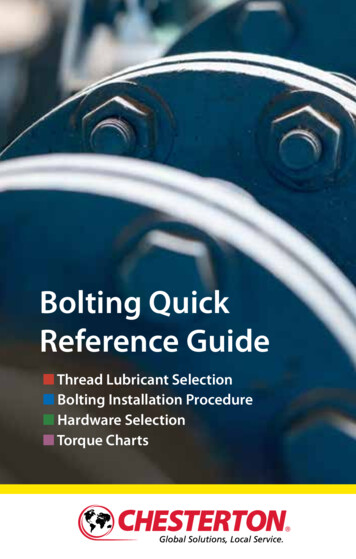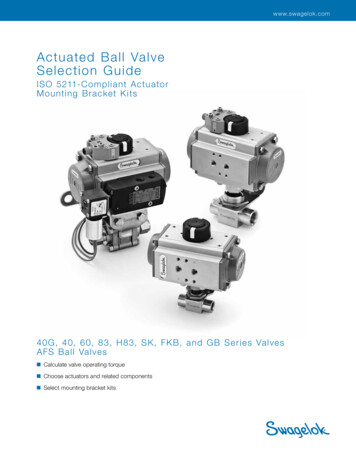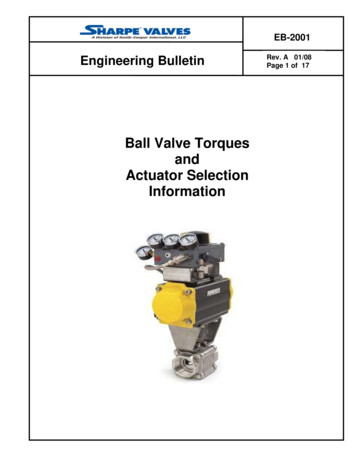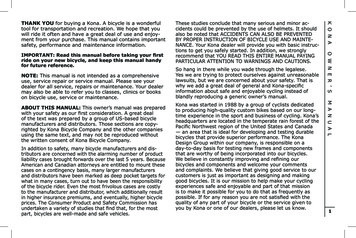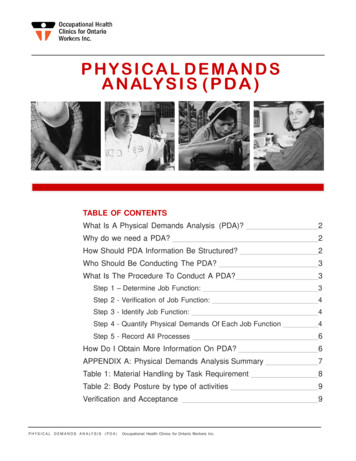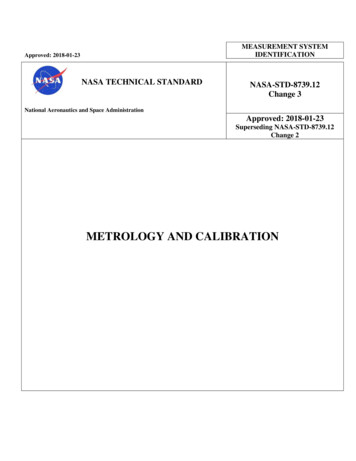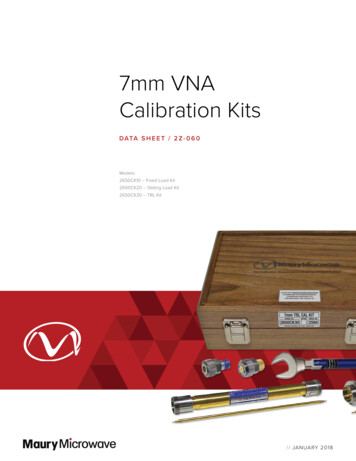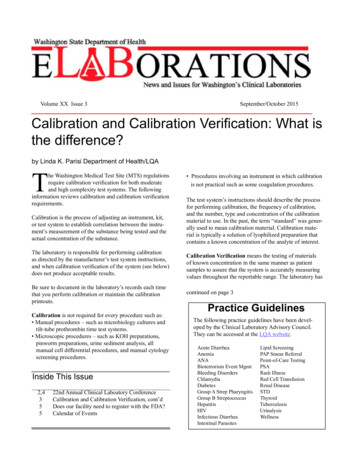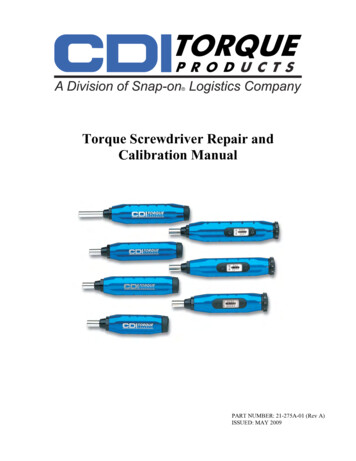
Transcription
Torque Screwdriver Repair andCalibration ManualPART NUMBER: 21-275A-01 (Rev A)ISSUED: MAY 2009
TABLE OF CONTENTSTITLEPAGE(S)SAFETY INSTRUCTIONS – WARNING & CAUTION1CDI TORQUE TESTING EQUIPMENT - AIR TOOLS REQUIRED3INSPECTION4ACCURACY VERIFICATION AND MINOR CALIBRATIONPROCEDURE4/8ASME B107.144ISO67894MINOR CALIBRATION ADJUSTMENT5/7MAJOR CALIBRATION ACCURACY ADJUSTMENT7/8How to check the Spherical Ball placement9/11How to re-engage the knob11Calibration Instructions for Pre-Set ScrewdriversCDI SCREWDRIVER TROUBLESHOOTING MATRIXi11/1213
REVISIONS –The Torque Screwdriver Repair Manual was originated and first issued on December2001. The manual will be reviewed and revised as necessary to assure that it contains thelatest changes in product or repair changes. In between revision, product bulletins may beissued to assure any changes in product or repairs are supplied to authorized repairfacilities.REV. Date IssuedDecember, 2001AMay, 2009Affected Pagesi, 3, 4, 6, 8, 9, 10 & 15 (now 13)Deleted pages 11 & 12Written By: Donna E. BrunotPhotographs By: Gary FitzhughiiApprovedE.S.
CDI ADJUSTABLE AND PRE-SET TORQUE SCREWDRIVER WRENCHREPAIR, MAINTENANCE AND TROUBLESHOOTING INSTRUCTIONSSAFETY INSTRUCTIONSFailure to follow WARNING instructions can cause personal injury to the operator.Failure to follow CAUTION instructions can cause the equipment to fail or break in use.! WARNINGAlways wear Safety Glasses or goggles when using or repairing hand tools.Read this manual completely before repairing torque wrenches.DO NOT use or tests a wrench that shows signs of damage (cracked or brokenparts) caused by misuse. Recommend replacement.Check all sockets or other test accessories for wear, damage or crack prior to theiruse with torque wrenches. Do not exceed their rated maximum torque.CAUTIONPeriodic recalibration is necessary to maintain accuracy.Periodic examination and cleaning is necessary to maintain the torque screwdriver.Page 1
BRATIONSYSTEMETTELECTRONICTORQUETESTERPage 2
INTRODUCTIONThis manual covers the calibration, repair, maintenance and a troubleshooting guide toidentify and remedy problems that could occur with CDI Torque Screwdrivers. Eachwrench model has an Exploded Illustration that lists the component parts and showsassembly particulars. The exploded illustration must be used as a guide for assemblingthe screwdrivers.CDI has a Service Centers that performs repairs and calibration on all of our products atthe factory, plus a list of factory authorized repair/calibration centers throughout theworld. Contact CDI Sales or Service Center at (626) 965-0668 or sales@cditorque.com fortechnical assistance on the repair or calibration of CDI products.CLEANINGWipe all exterior parts with a dry, clean and lint free cloth. DO NOT USE any abrasiveor corrosive materials to clean any components of CDI Torque Wrenches.LUBRICATIONSuper Lube MULTI-Purpose Synthetic Lubrication with Teflon, CDI Part #101000. NO SUBSTITUTES ALLOWED.REPAIR TOOLS REQUIREDCDI Torque Screwdrivers*111111Torque Tester (range determined by the torque wrench to be tested)1/8” Hex “T” shape9/16” Open End Wrench¾” Open End WrenchQC1I200Torque Wrench1/16” Hex3/8” Sq. Dr. ratchet head “J” shank*We recommend that CDI torque testers be used to test the calibration accuracy ofCDI manufactured torque products.CDI manufactures a complete line of torque testing equipment from moderatelypriced testers to complete state of the art test systems used in metrology calibrationlaboratories all over the world. Contact CDI Sales or Service Center at (626) 9650668 or sales@cditorque.com.Page 3
INSPECTIONInspect all wrenches repaired to determine that they are in an operational condition byvisually inspecting for worn, broken, cracked or damaged parts. Replace parts not foundto be in satisfactory condition.ACCURACY VERIFICATION AND MINOR CALIBRATION PROCEDUREThis procedure is to be used to check the accuracy and, if necessary, perform a minoradjustment on calibration. It must also be used after a major calibration.There are two major international standards that establish torque wrench accuracyrequirements. They are ASME B107.14 Hand Torque Tools (American Society ofMechanical Engineers) and ISO 6789 Hand Torque Tools – Requirements and TestMethods (International Organization for Standardization). Both standards are recognizedas established accuracy test methods and referenced in this section. ASME and ISOstandards are subject to review and changes. The repair manual will be reviewed andrevised periodically but may not reflect the latest revisions of the specifications listedabove.ASME B107.141. Preload the wrench by setting the wrench at 100% of full scale and operating threetimes on the tester.2. Reset handle to 20% of full scale. Take 3 readings at 20%.3. Set and test the wrench three (3) times at 60% and 100% of full scale noting theaccuracy error for each reading. If the readings are within the accuracy requirementsfor the direction ( 6% or readings), no calibration adjustment is required.ISO 67891. Preload the wrench by setting the wrench at 100% of full scale and operating five (5)times in the direction of the test.2. Reset handle to 20% of full scale.3. Test the wrench five (5) times at 20% noting the accuracy error for each reading. Setand test the wrench five (5) times at 60% and 100% of full scale noting the accuracyerror for each reading. If the readings are within the accuracy requirements for thetest direction ( 6% or readings), no calibration adjustment is required.Page 4
Minor Calibration Accuracy AdjustmentNOTEA minor (knob/scale) adjustment is used to adjust 20% of the scale reading. If the readingat 20% and 100% of scale are both either high or low to the required accuracy, a minoradjustment may be used to bring the accuracy within torque specification. If the torquewrench requires minor adjustment follow steps 4 through 8.4. Set the knob so that the scale is at 20% of full scale. Remove the plug from the end ofthe knob.5. Test the screwdriver and Adjust the handle, clockwise to increase andcounterclockwise to decrease the reading, until the screwdriver read withinspecification of the 20% reading (example: For a 100 IN.OZ. CDI screwdriver, the lowreading is 20 IN.OZ. and 18.8 to 21.2 IN.OZ. is the tolerance).Page 5
6. Place the 1/8” T-Shaped Hex in the back of the knob and Loosen the set screw. Pullthe knob back and turn it until it is on the “0” increment of the knob is aligned withthe 20% increment of the scale. Push the knob back to engage it and tighten the setscrew. Recheck the reading.7. Use a 1/16” hex in a screwdriver to loosen and remove the 2 (two) screws on thescale bezel. Remove the bezel. Move the scale until the increment line is aligned tothe lowest increment.8. Place the Bezel over the scale and tighten the screws. Recheck the readings at 20, 60and 100% of scale. If the screwdriver is calibrated torque the Bezel screws at 3 .2 IN.LB.Then the set screw to 60 2 IN.LB. Place a new end plug on the end of the screwdriver.Page 6
9. If a minor calibration cannot be used to calibrate the screwdriver, perform a majorcalibration.Major Calibration Accuracy AdjustmentNOTEA major (nose cone) adjustment is used to adjust all of the scale reading. If the reading at20%, 60 and 100% of scale are either to high or low to the required accuracy to adjustwith a minor adjustment, a major adjustment must be used to bring the accuracy withintorque specification. If the torque wrench requires major adjustment follow steps 1through 4.1. Use a ¾” open-end wrench, turning it clockwise, to loosen and remove the cone nut.2. Turn the cone to set the calibration as follows:a.) If the reading on the tester was below the accuracy limit for the value tested turnthe cone clockwise to increase the value. Test and repeat this procedure until thereadings are within the accuracy limits or a minor adjustment could be used tobring the wrench within the accuracy limits.b.) If the reading on the tester was above the accuracy limit for the value tested turnthe cone counterclockwise to decrease the value. Test and repeat this procedureuntil the readings are within the accuracy limits or a minor adjustment could beused to bring the wrench within the accuracy limits.Page 7
3. Replace the cone nut and tighten counterclockwise. Then tighten the cone nut to 80 3IN.LB.4. Perform an accuracy check and, if required, a minor calibration adjustment.ORPage 8
How to check the Spherical Ball PlacementNOTEIf the torque screwdriver jams or does not turn the spherical balls can be the problem.Follow steps 1 through 7 to check and/or replace the spherical balls.1. Use a ¾” open end wrench, turning it clockwise, to loosen and remove the cone nut.2. Turn the cone counterclockwise to the remove from cone from the screwdriver.3.Remove the cam from the screwdriver.Page 9
4. Inspect the secondary cam to assure that the spherical balls (2) are in place in thesecondary cam. If they are not, grease lightly to hold them in the secondary cam.5. Grease the cam.6. Place the cam into the cone and screw into place.Page 10
7. Perform a major calibration adjustment to bring the screwdriver within the accuracylimits or a minor adjustment could be used to bring the wrench within the accuracylimits.How to re-engage the knob.1. If the knob becomes disengaged, Line up the decagon on the knob with the decagonon the inside of the screwdriver. Apply a force until the knob re-engages.2. Perform a minor calibration adjustment to set the low reading.Calibration Instructions for a Pre-Set CDI Screwdriver.1. Remove the plug from the end of the knob.Page 11
3. Place the 1/8” T-Shaped Hex in the back of the screwdriver and Turn the set screw toset the calibration as follows:c.) If the reading on the tester was below the accuracy limit for the value tested turnthe set screw clockwise to increase the value. Test and repeat this procedure untilthe readings are within the accuracy limits.2. If the reading on the tester was above the accuracy limit for the value tested turn theset screw counterclockwise to decrease the value. Test and repeat this procedureuntil the readings are within the accuracy limits.3. Place the end plug on the end of the screwdriver.Page 12
CDI SCREWDRIVER TROUBLESHOTTING MATRIXPROBLEMREMEDYCalibration accuracy at 20% of scale Perform a minor calibration adjustment.is out of tolerance.NOTEIf a minor calibration fails to bring the 20% of scalereading into tolerance or if adjustment causes the60% or 100% of scale to fall out of the tolerance amajor calibration is required.ORCalibration accuracy at 20%, 60% Perform a major calibration.and 100% of scale is out of tolerance.ORCalibration accuracy at 60% and100% of scale is out of tolerancePerform a major calibration.The screwdriver is jammed.See repair instructions for spherical ball.Knob disassembled from screwdriverSee knob engagement instructions.Page 13
CDI Torque Screwdrivers * Torque Tester (range determined by the torque wrench to be tested) 1 1/8" Hex "T" shape 1 9/16" Open End Wrench 1 ¾" Open End Wrench 1 QC1I200Torque Wrench 1 1/16" Hex 1 3/8" Sq. Dr. ratchet head "J" shank *We recommend that CDI torque testers be used to test the calibration accuracy of
